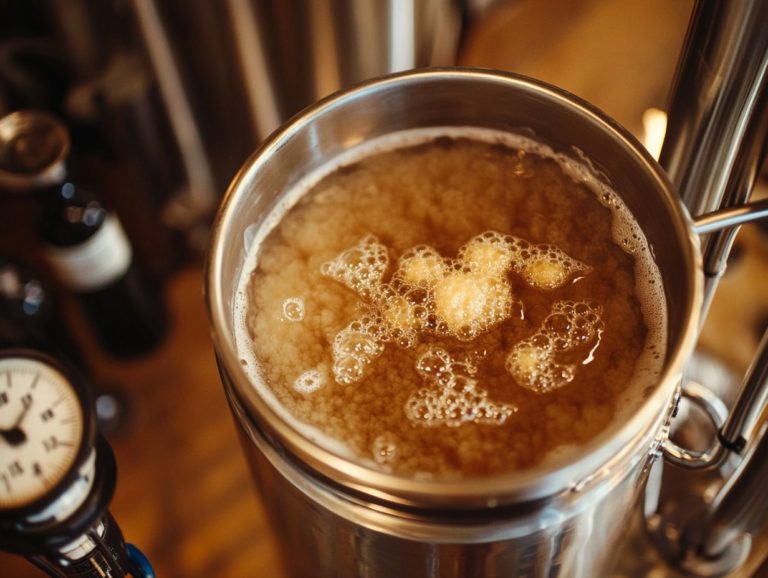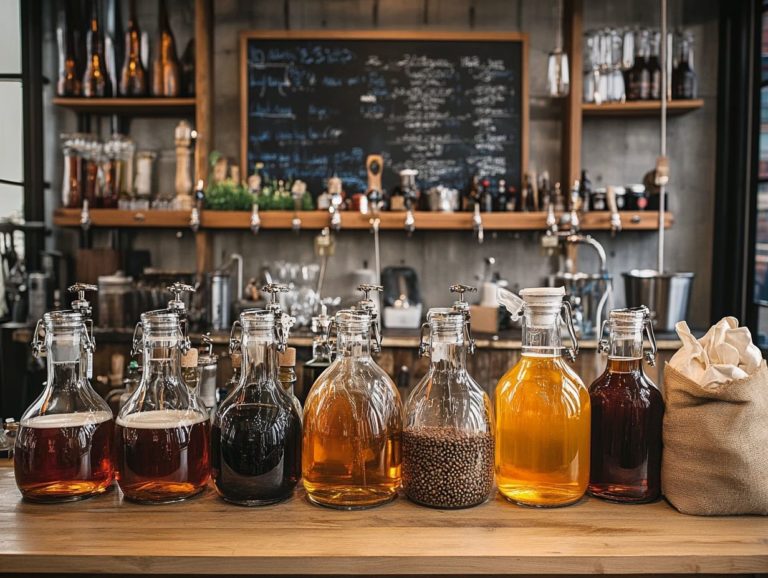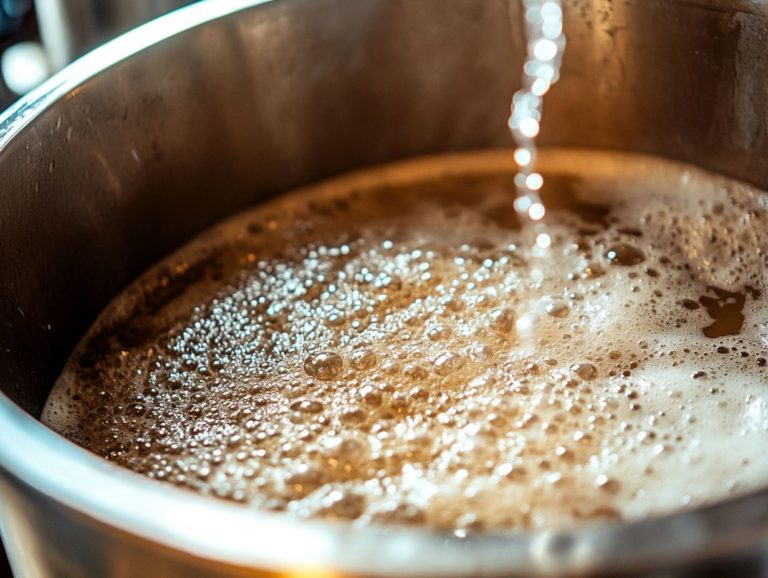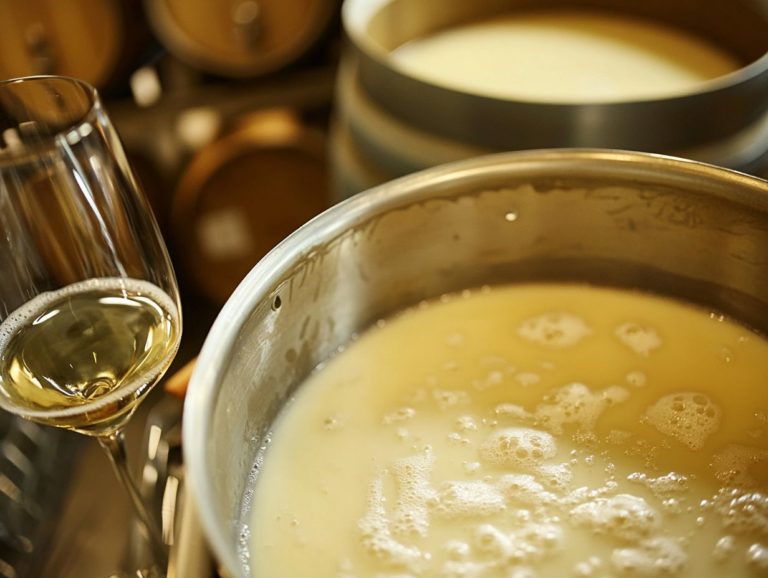The Effect of Altitude on Fermentation
Altitude plays a pivotal role in the fermentation process, shaping everything from yeast activity to temperature regulation. As you ascend, the environment shifts dramatically, influencing the production of substances like wine, beer, and bread. This is particularly noticeable in regions like Colorado Springs, which faces unique high-altitude brewing challenges.
This exploration delves into how high-altitude conditions affect fermentation, highlighting the challenges and adaptations necessary for achieving successful results. Whether you’re a home brewer, winemaker, bread enthusiast, or even a Yak herder in the Qinghai-Tibet Plateau, grasping these dynamics can elevate your craft to new heights.
Dive into the fascinating world of altitude and fermentation now and discover how it can elevate your craft!
Contents
- Key Takeaways:
- How Does Altitude Affect Fermentation?
- What Happens to Temperature During Fermentation at High Altitudes?
- What Happens to Oxygen Levels During Fermentation at High Altitudes?
- What Are the Different Types of Altitude?
- 1. Low Altitude
- 2. Mid Altitude
- 3. High Altitude
- How Does Altitude Affect Different Types of Fermentation?
- What Are the Challenges of Fermentation at High Altitudes?
- Conclusion
- Frequently Asked Questions
- What is the effect of altitude on fermentation?
- How does altitude impact the flavor of fermented products?
- Can fermentation take place at high altitudes?
- Why is it important to consider altitude when fermenting?
- Is there a particular altitude range that is best for fermentation?
- How can altitude be managed when fermenting at high altitudes, such as in regions like the Qinghai-Tibet Plateau?
Key Takeaways:

- High altitude can slow down and even halt fermentation due to changes in yeast activity and oxygen levels, leading to longer fermentation times and potential flavor discrepancies, impacting both traditional bread baking and advanced brewing techniques.
- The type of fermentation, such as wine, beer, bread, or even rumen fermentation in yaks, can also be affected by altitude, with each having its own unique challenges and considerations.
- Temperature control is increasingly important at higher altitudes, as the cooler temperatures can slow fermentation or even cause it to stop altogether. This makes the use of pressure cookers and other cooking adjustments essential in high-altitude environments.
How Does Altitude Affect Fermentation?
Altitude significantly influences fermentation processes, shaping the behavior of yeast, enhancing the variety of microbes, and impacting fermentation efficiency in various food preservation methods.
In areas such as Colorado Springs, the unique challenges and opportunities presented by higher altitudes can greatly affect brewers, bakers, and food enthusiasts. Variations in atmospheric pressure and oxygen levels can alter fermentation parameters. This influences everything from yeast activity to the nutritional profile of fermented products.
The microbial diversity, including Bacteroidetes and Firmicutes, plays a crucial role in the fermentation efficiency and nutritional profiling of food items. Grasping these effects is essential for optimizing your brewing and cooking techniques, allowing you to preserve both flavor and nutritional value in high-altitude environments. Cooking adjustments are necessary to account for the differences in boiling points and water evaporation rates at high altitudes.
What Happens to Yeast at High Altitudes?
At high altitudes, you ll notice that yeast undergoes significant changes that can impact fermentation efficiency and overall performance. This is especially relevant for dry yeast varieties, which may require specific handling to adapt to lower oxygen availability.
These changes arise primarily from the reduced atmospheric pressure and lower oxygen availability. This can slow down metabolic activity and alter gas production during fermentation. Different yeast strains come with their own unique tolerances to these extreme conditions, influencing not only their growth rates but also the flavor profiles they produce.
Some high-altitude-adapted strains may actually thrive, exhibiting faster fermentation rates despite the challenging environment, while others might struggle under the stress of diminished oxygen levels. Notably, the rumen microbiota of yaks, including Ruminococcus_1 and Christensenellaceae_R-7_group, have evolved to adapt to these high-altitude conditions, optimizing fermentation for energy harvesting.
Understanding these distinct adaptations is essential for you as a brewer or baker aiming for optimal results. It enables you to select the most suitable yeast for higher elevations, ensuring your creations shine even in challenging conditions.
What Happens to Temperature During Fermentation at High Altitudes?
Temperature significantly influences the fermentation process. When you’re at high altitudes, the boiling point of water drops, changing fermentation dynamics.
This reduction means activities like baking bread or brewing beer need precise adjustments for the best outcomes! For instance, while yeast flourishes in warmer temperatures at sea level, you must manage temperatures at higher elevations to avoid over-proofing or not rising enough.
Common adjustments you might consider include:
- Increasing the amount of liquid in your bread recipes to counter higher water evaporation rates.
- Slightly lowering oven temperatures to avoid setting the crust too quickly and ensuring even cooking times.
In terms of brewing, that lower boiling point can accelerate the extraction of flavors and sugars, compelling you to tweak your recipes. This could involve:
- Modifying hop additions.
- Adjusting fermentation times.
These adaptations are crucial for success at high altitudes. For example, recipes for high-altitude brownies often call for a reduced sugar ratio to balance the effects of increased leavening, ensuring you achieve that rich, moist texture despite the altitude’s challenges.
What Happens to Oxygen Levels During Fermentation at High Altitudes?
Now, let’s explore how oxygen levels affect fermentation at high altitudes. At high altitudes, the decrease in oxygen levels can significantly impact the fermentation process, leading to alterations in microbial diversity and yeast activity. This is particularly evident in the rumen fluid of yaks, where the microbial community adapts for efficient energy metabolism.
In these unique environments, yeast and other microorganisms must adapt to the lower oxygen conditions, often enhancing their fermentation efficiency through various metabolic pathways, which are the processes by which organisms convert food into energy. This adaptation can dramatically change flavor profiles and fermentation kinetics something every brewer should be aware of!
Understanding these adaptations is key to mastering food preservation techniques, as many of your preservation methods rely on the metabolic activity of microorganisms. Therefore, the interplay between oxygen availability and fermentation not only influences your brewing practices but also has broader implications for food safety and shelf-life, creating an environment ripe for innovative techniques to thrive. Notably, the work of food scientists like Harold McGee and Kenji Lopez-Alt has shed light on these intricate processes.
What Are the Different Types of Altitude?
You can categorize altitudes into three primary types: low, mid, and high, each presenting its own unique challenges and opportunities for fermentation and food preparation. This altitude influence also extends to the nutrient composition and dietary fiber content of local produce, affecting overall food quality.
At low altitudes, you ll find optimal conditions that promote yeast activity and enhance microbial diversity. As you move to mid and high altitudes, factors such as reduced oxygen levels and lower boiling points come into play, demanding specific adjustments in your cooking techniques. Mid-altitude herbage utilization and energy harvesting in ruminants such as Tibetan sheep highlight these unique challenges.
Grasping these distinctions is essential for brewers, bakers, and food scientists who strive to optimize fermentation processes and fine-tune recipes across varying elevations.
So, are you ready to take your high-altitude baking and brewing to the next level?
1. Low Altitude

Low altitudes offer remarkable conditions for fermentation. They provide higher oxygen levels and stable temperatures that truly elevate yeast activity and microbial diversity.
This unique environment fosters the development of complex flavors and aromas, especially evident in artisanal bread making and craft brewing. For instance, you may find that bakers often note the distinct characteristics of sourdough from low-elevation regions, showcasing a tangy profile paired with a delightfully chewy texture that delights the palate. Low altitude also promotes optimal dietary fiber and carbohydrate metabolism, enhancing the flavor and texture of baked goods.
In a similar vein, craft breweries take full advantage of low-altitude fermentation, resulting in beers that burst with vibrant fruity and floral notes, thanks to the diverse yeast strains that thrive in these conditions. Moreover, the nutritional profile of fermented products tends to improve as beneficial microbes flourish, promoting the breakdown of nutrients and enhancing bioavailability (the degree to which nutrients are absorbed in the body), ultimately contributing to a healthier end product.
These advantages highlight the importance of low altitude environments in crafting superior fermented goods, making them truly exceptional.
2. Mid Altitude
Mid altitudes offer a unique blend of low oxygen challenges and the advantages of stable temperatures, shaping the intricacies of fermentation dynamics.
Pay careful attention to temperature control and yeast selection to achieve optimal fermentation. For example, when you engage in winemaking at elevations between 2,000 and 4,000 feet, you might need to utilize particular yeast strains capable of withstanding cooler fermentation temperatures, as traditional varieties may falter in these conditions. You may also find inspiration in local fruits or grains that flourish at these altitudes perhaps incorporating barley grown in highlands into your beer recipes or selecting unique grapes for your wine to create flavors that genuinely represent the region’s character. Altitude-cultivated honey has become popular, highlighting how mid-altitude environments can produce distinctive and unique flavors.
3. High Altitude
High altitudes present unique challenges for fermentation that you must navigate, such as diminished oxygen levels and lower boiling points, requiring precise adjustments in your cooking methods to achieve optimal results.
These conditions can slow down yeast performance, influencing both fermentation time and the overall quality of your final product. For instance, you may notice that your dough rises more slowly due to the decreased atmospheric pressure, prompting you to tweak the quantities of yeast or extend fermentation durations. Brewers may also find that their beer takes longer to ferment completely, potentially affecting the flavor profiles. The diet of yaks, alongside fermentation of herbs, adapts to high altitudes, leading to changes in nutrient composition and energy metabolism.
To conquer these elevation-related hurdles, consider these practical tips:
- Use a thermometer to monitor temperatures accurately during cooking.
- Allow more time for proofing your dough to achieve the best rise.
- Consider increasing hydration levels in your dough recipes to counter the dry air, ensuring a superior texture and rise.
How Does Altitude Affect Different Types of Fermentation?
Altitude influences various fermentation parameters and cooking adjustments, necessitating specific changes in food preparation methods. For instance, high-altitude cooking often requires modified recipes and longer cooking times to account for the differences in environmental conditions.
Altitude plays a crucial role in shaping the fermentation processes of wine, beer, and bread. Each of these requires specific adaptations to achieve the desired outcomes, highlighting the intricate relationship between elevation, pressure cookers, and fermentation.
Understanding this influence allows you to master the nuances of each fermentation type, ensuring successful results tailored to your location and altitude effects.
1. Wine Fermentation at High Altitude
Wine fermentation at high altitudes presents distinctive challenges. You will discover cooler temperatures and reduced oxygen levels that can influence yeast activity and flavor development.
As you explore the elevated vineyards, winemakers face these conditions, requiring a thoughtful approach to grape selection and yeast strains. Grapes that flourish in harsher climates often display unique characteristics, embodying the essence of their environment.
The cooler temperatures require precise fermentation temperature control. Vintners implement strategies to maintain the delicate balance of flavors, often inspired by experts like Harold McGee and Kenji Lopez-Alt.
Selecting yeast strains that thrive in lower oxygen conditions often leads to wines with enhanced acidity and vibrant fruit notes. This results in a flavor profile that is as unique as it is memorable for enthusiasts.
These insights reveal the intricate relationship between altitude and the art of winemaking.
2. Beer Fermentation at High Altitude
Beer fermentation at high altitudes demands meticulous attention to yeast activity and brewing conditions to ensure a successful brew.
The unique environmental conditions at elevated elevations present specific challenges. As altitude increases, the boiling point of water decreases, which can lead to under-extraction of flavors during the boiling phase.
This under-extraction may result in a less pronounced hop character in your final product. Temperature control also becomes a delicate balancing act.
Yeast tends to ferment more vigorously in cooler environments, creating a risk of off-flavors if not properly monitored. Successful high-altitude breweries, like those in Colorado and Utah, often modify their brewing techniques.
They utilize insulated fermentation tanks and closely monitor temperature fluctuations to maintain optimal yeast performance. These adaptations help manage the fermentation process and contribute to unique and flavorful beers.
3. Bread Fermentation at High Altitude

Bread fermentation at high altitudes presents unique challenges. Thoughtful adjustments in your ingredients and fermentation times are necessary to achieve optimal results.
As you ascend in elevation, the decrease in atmospheric pressure dramatically influences how your bread dough rises and bakes. Consider increasing the hydration levels in your dough, as the dry air at higher altitudes can cause moisture to evaporate quickly.
It might also be advantageous to reduce the yeast quantity by about 25%. The faster fermentation process at high altitudes can easily lead to overproofed dough if you’re not careful.
Keep a close eye on proofing times; your dough is likely to double in size more rapidly than at lower elevations. Embrace the art of experimentation with these variables.
Track your outcomes to refine your high-altitude bread recipe and consider the role of high-altitude cooking techniques to enhance your baking.
What Are the Challenges of Fermentation at High Altitudes?
Fermentation at high altitudes introduces various challenges that you must navigate skillfully. You will encounter shifts in yeast activity, difficulties maintaining optimal temperature control, fluctuations in oxygen levels, and prolonged fermentation times.
All of these factors can significantly affect the quality of your final product. This is particularly true for high-altitude brewing, where careful adjustments in fermentation conditions are essential.
Conclusion
In summary, fermentation at high altitudes presents unique challenges across different domains, including wine, beer, and bread. Understanding and adapting to these conditions can lead to exceptional and distinctive products that reflect the character of their environment.
1. Changes in Yeast Activity
At high altitudes, you may notice that yeast activity tends to decline due to lower oxygen levels and fluctuating temperatures. This can significantly affect your fermentation outcomes.
This decline can result in slower fermentation rates, ultimately impacting the overall efficiency of your fermentation process. Under these challenging conditions, yeast strains might struggle to maintain their metabolic functions. Therefore, it is essential to carefully consider your yeast choices.
Opting for strains specifically adapted to high-altitude environments can greatly enhance both your fermentation efficiency and flavor development. These resilient strains are better equipped to handle reduced oxygen and temperature variations, leading to more complex and refined flavor profiles in your finished product.
2. Changes in Temperature Control
Temperature control poses a unique challenge at high altitudes, where lower boiling points and fluctuating external temperatures can complicate the fermentation process.
As you ascend in elevation, the yeast and bacteria vital to fermentation may become less active or exhibit unpredictable behavior when confronted with temperature variations. This unpredictability could introduce off-flavors or yield less-than-ideal fermentation outcomes, whether you’re brewing beer or baking bread.
To navigate these challenges, you must adapt your recipes and techniques accordingly. For instance, consider these adjustments:
- Increase the fermentation time
- Lower the fermentation temperatures
- Incorporate more resilient strains of yeast that thrive in altitude conditions
By diligently monitoring your processes and embracing a spirit of experimentation, you can achieve the desired flavors and textures, overcoming the environmental hurdles that high-altitude baking and brewing present.
3. Changes in Oxygen Levels
Reduced oxygen levels at high altitudes can significantly hinder fermentation by affecting yeast activity and microbial diversity. In these oxygen-deprived conditions, yeast finds it challenging to thrive, resulting in slower fermentation rates and the potential introduction of off-flavors in the final product. Understanding these challenges is crucial for successful high-altitude brewing.
Since oxygen is vital for yeast metabolism, its scarcity can lead to incomplete fermentation, leaving behind residual sugars (the sugars that remain unfermented) that may alter the overall taste and quality of your beverage. Additionally, limited oxygen availability restricts the growth of beneficial microorganisms, further jeopardizing fermentation outcomes.
This situation highlights the necessity of addressing the challenges associated with wine making. By doing so, you can ensure that your beverages achieve the desired characteristics and maintain their exceptional quality.
4. Changes in Fermentation Time
At high altitudes, you may find that fermentation times can stretch longer than expected due to environmental factors like lower temperatures and reduced yeast activity. Careful monitoring is essential.
As you ascend to higher elevations, the decreasing atmospheric pressure can slow down the fermentation process. Yeast, the critical agent in fermentation, may struggle to perform at its best in these conditions. This necessitates adjustments in parameters such as temperature and nutrient addition. The same considerations apply for cooking, where cooking times and recipes may need to be altered.
Whether you’re a winemaker or a brewer, it s vital to remain particularly attentive to these changes. They influence not only the duration of fermentation but also the final flavor profile and overall quality of your product. Delays in fermentation could lead to off-flavors or overly sweet characteristics, emphasizing the need for you to adapt your techniques to achieve the desired outcome.
Frequently Asked Questions
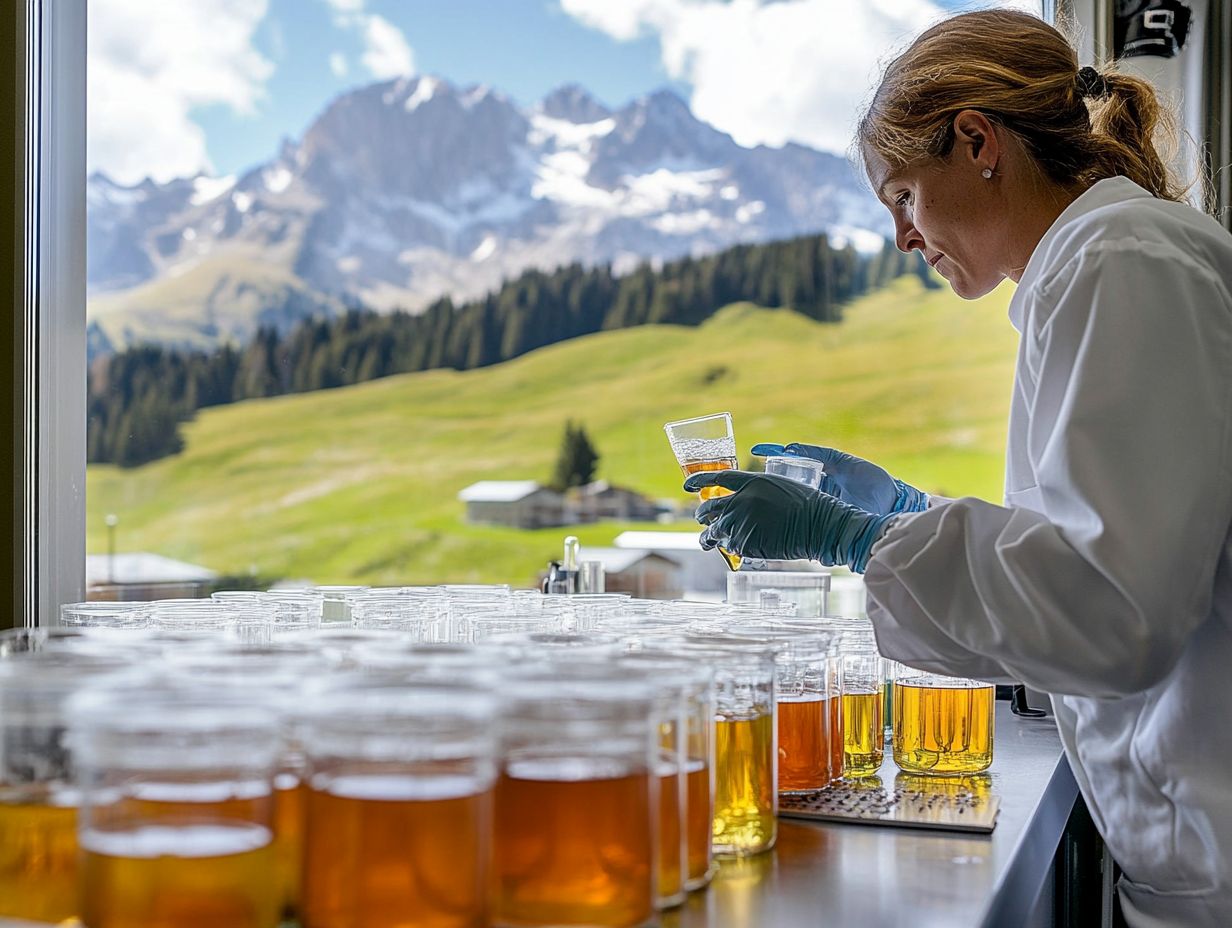
What is the effect of altitude on fermentation?
Altitude significantly affects fermentation. At higher altitudes, air pressure decreases, leading to lower dissolved oxygen levels, which are essential for yeast growth during fermentation.
Reduced air pressure also influences water evaporation rates. This can affect cooking adjustments and food preparation.
How does altitude impact the flavor of fermented products?
Lower oxygen levels at high altitudes can slow down fermentation, resulting in off-flavors and a less desirable end product. Different microorganisms present at various altitudes also influence the flavor profile of fermented products.
Can fermentation take place at high altitudes?
Yes, fermentation can occur at high altitudes, but it may be slower and require different techniques to succeed.
Why is it important to consider altitude when fermenting?
Understanding the effects of altitude is crucial for successful fermentation. It greatly impacts the quality and outcome of the fermentation process.
Is there a particular altitude range that is best for fermentation?
Moderate altitudes are often preferred for optimal fermentation. Extreme high altitudes introduce challenges like reduced oxygen levels and lower boiling points.
Most fermentation processes perform better at lower altitudes (below 1000 meters) due to higher oxygen levels. However, some products, like those from Colorado Springs, may benefit from higher altitudes (above 2000 meters) for unique flavor development.
How can altitude be managed when fermenting at high altitudes, such as in regions like the Qinghai-Tibet Plateau?
To manage altitude during fermentation, adjust the fermentation time and temperature. Consider using different yeast strains, like dry yeast, and pressure techniques to boost oxygen levels.
Using pressure cookers can help simulate conditions found at lower altitudes. Consult with fermentation experts and experiment with different techniques to achieve desired results at high altitudes. These adjustments can significantly affect carbohydrate metabolism and energy harvesting.


